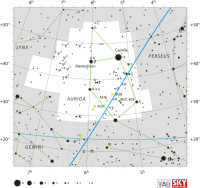
Asteroseismology of hybrid δ Scuti-γ Doradus pulsating stars
Sign Up to like & getrecommendations! Published in 2017 at "Astronomy and Astrophysics"
DOI: 10.1051/0004-6361/201629126
Abstract: Context. Hybrid δ Scuti- γ Doradus pulsating stars show acoustic ( p ) oscillation modes typical of δ Scuti variable stars, and gravity ( g ) pulsation modes characteristic of γ Doradus variable stars simultaneously… read more here.
Keywords: scuti doradus; hybrid scuti; doradus pulsating; asteroseismology ... See more keywords

Asteroseismic data analysis: foundations and techniques
Sign Up to like & getrecommendations! Published in 2019 at "Contemporary Physics"
DOI: 10.1080/00107514.2019.1662096
Abstract: Stars pulsate and their nature of their pulsations can provide a great deal of information about them including, for example, their masses, radii and ages. Oscillations in stellar brightness were first observed long ago, at… read more here.
Keywords: analysis foundations; data analysis; foundations techniques; asteroseismic data ... See more keywords

Gravitational wave asteroseismology limits from low density nuclear matter and perturbative QCD
Sign Up to like & getrecommendations! Published in 2018 at "Journal of Cosmology and Astroparticle Physics"
DOI: 10.1088/1475-7516/2018/08/046
Abstract: We investigate the fundamental mode of non-radial oscillations of non-rotating compact stars in general relativity using a set of equations of state (EOS) connecting state-of-the-art calculations at low and high densities. Specifically, a low density… read more here.
Keywords: gravitational wave; equations state; density; low density ... See more keywords

Asteroseismology of luminous red giants with Kepler – II. Dependence of mass-loss on pulsations and radiation
Sign Up to like & getrecommendations! Published in 2020 at "Monthly Notices of the Royal Astronomical Society"
DOI: 10.1093/mnras/staa3970
Abstract: Mass-loss by red giants is an important process to understand the final stages of stellar evolution and the chemical enrichment of the interstellar medium. Mass-loss rates are thought to be controlled by pulsation-enhanced dust-driven outflows.… read more here.
Keywords: loss rates; mass loss; red giants; asteroseismology ... See more keywords

Prospects for Galactic and stellar astrophysics with asteroseismology of giant stars in the TESS continuous viewing zones and beyond
Sign Up to like & getrecommendations! Published in 2021 at "Monthly Notices of the Royal Astronomical Society"
DOI: 10.1093/mnras/stab098
Abstract: The NASA Transiting Exoplanet Survey Satellite (NASA-TESS) mission presents a treasure trove for understanding the stars it observes and the Milky Way, in which they reside. We present a first look at the prospects for… read more here.
Keywords: prospects galactic; astrophysics; stellar astrophysics; giant stars ... See more keywords

Beyond the Kepler/K2 bright limit: Variability in the seven brightest members of the Pleiades
Sign Up to like & getrecommendations! Published in 2017 at "Monthly Notices of the Royal Astronomical Society"
DOI: 10.1093/mnras/stx1050
Abstract: The most powerful tests of stellar models come from the brightest stars in the sky, for which complementary techniques, such as astrometry, asteroseismology, spectroscopy, and interferometry can be combined. The K2 Mission is providing a… read more here.
Keywords: bright stars; variability; seven brightest; beyond kepler ... See more keywords

Deep learning classification in asteroseismology
Sign Up to like & getrecommendations! Published in 2017 at "Monthly Notices of the Royal Astronomical Society"
DOI: 10.1093/mnras/stx1174
Abstract: In the power spectra of oscillating red giants, there are visually distinct features defining stars ascending the red giant branch from those that have commenced helium core burning. We train a one-dimensional convolutional neural network… read more here.
Keywords: deep learning; red giants; asteroseismology; classification asteroseismology ... See more keywords

Theoretical oscillation frequencies for solar-type dwarfs from stellar models with 〈3D〉-atmospheres
Sign Up to like & getrecommendations! Published in 2017 at "Monthly Notices of the Royal Astronomical Society"
DOI: 10.1093/mnras/stx2226
Abstract: We present a new method for replacing the outermost layers of stellar models with interpolated atmospheres based on results from 3D simulations, in order to correct for structural inadequacies of these layers. This replacement is… read more here.
Keywords: theoretical oscillation; frequencies solar; solar type; asteroseismology ... See more keywords

Modelling Kepler red giants in eclipsing binaries: calibrating the mixing-length parameter with asteroseismology
Sign Up to like & getrecommendations! Published in 2018 at "Monthly Notices of the Royal Astronomical Society"
DOI: 10.1093/mnras/stx3079
Abstract: Stellar models rely on a number of free parameters. High-quality observations of eclipsing binary stars observed by Kepler offer a great opportunity to calibrate model parameters for evolved stars. Our study focuses on six Kepler… read more here.
Keywords: asteroseismology; red giants; mixing length; length parameter ... See more keywords

KOI-3890: a high-mass-ratio asteroseismic red giant+M-dwarf eclipsing binary undergoing heartbeat tidal interactions
Sign Up to like & getrecommendations! Published in 2019 at "Monthly Notices of the Royal Astronomical Society"
DOI: 10.1093/mnras/stz1185
Abstract: KOI-3890 is a highly eccentric, 153-d period eclipsing, single-lined spectroscopic binary system containing a red giant star showing solar-like oscillations alongside tidal interactions. The combination of transit photometry, radial velocity observations, and asteroseismology has enabled… read more here.
Keywords: system; asteroseismology; mass; dwarf ... See more keywords

Asteroseismology of main-sequence F stars with Kepler: overcoming short mode lifetimes
Sign Up to like & getrecommendations! Published in 2019 at "Monthly Notices of the Royal Astronomical Society"
DOI: 10.1093/mnras/stz432
Abstract: Asteroseismology is a powerful way of determining stellar parameters and properties of stars like the Sun. However, main-sequence F-type stars exhibit short mode lifetimes relative to their oscillation frequency, resulting in overlapping radial and quadrupole… read more here.
Keywords: mode; short mode; main sequence; mode lifetimes ... See more keywords